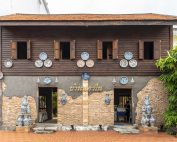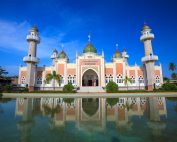Lampang Old Town
Coming to Lampang is like stepping back into ancient the city of Khe Lang Nakhon (Khe Lang City) and despite the passing of centuries, very little has changed here. The Lanna culture, arts and civilization are reflected in the remaining temples, museums and walking streets in classic residential neighbourhoods. Despite the march of modernization, Lampang retains many aspects of its original lifestyle, and that’s what makes it so worth visiting.
Visitors can experience the ancient grace of the culture and arts of Nakhon Lampang or Khe Lang Nakhon, a prosperous trade center during Hariphunchai period around 1,300 years ago. Start with the ancient city gates adorned with trademark Lanna art and continue to Wat Pong Sanuk Nuea with its magnificent wooden Wihan Phra Chao Phan Ong (Vihara of Thousand Buddhas), which is decorated with indescribably intricate traditional Thai fine art patterns. More than 1,080 small votive Buddha tablets line the interior walls, and four Buddha images face outwards in all four directions. This holy place received an Award of Merit for Cultural Heritage Conservation from UNESCO in B.E. 2551 (2008). There’s also Wat Si Chum, the largest Burmese temple in Thailand, built from wood and imaginatively furnished with well-preserved Burmese and Mon arts. The golden chedi enshrines the Buddha’s relics, which were obtained from Burma for public worship and to grant blessings and good fortune.
Other must-visit places include Ho Amok (ancient cannon tower), Wat Klang Wiang (Wat Bunyawatwihan), Wat Nam Lom, Wat Pa Dua, Wat Muen Kat, and Chao Mae Yot Kham House and Baan Sao Nak, the teakwood house of a wealthy Burmese settler that clearly demonstrates the wondrous artistic skill of the craftsmen of that period.
A Lampang trip is not complete without a ride in a horse-drawn carriage. These ancient vehicles are recognized as the city symbol and have recently adopted a solar cell panel as a power source to light the way in an environmentally friendly manner. Also, Lampang residents have kindly taken it upon themselves to welcome tourists by opening up their houses as information centres where the historical background of this wonderful city can be learnt as well as details regarding the production of Lampang’s signature rooster-branded ceramic bowls, which can be found in homes and restaurants across the country. Tourists can help support community products by picking up some attractive souvenirs.
Before leaving Lampang, make sure to visit Kat Kong Ta Walking Street. During the reign of King Rama V, it was known as Talat Chin (Chinese Market) after a large group of travelling Chinese began to trade there. The walking path is flanked by centuries-old buildings in a seamlessly contemporary architectural style with Chinese, European and Burmese elements Down by the Wang river you will find a wonderful atmosphere with plenty of guesthouses for visitors wishing to experience the local lifestyle up close. It is a wonderful place to stroll around, support local products that generate sustainable income for the community or to stop by to write and send a postcard filled with impressive memories to yourself or to friends inviting them to follow in your footsteps and explore. If you do though, remind them to travel responsibly and be aware of the rules and guidelines which help maintain tourist attractions, especially ones as impressive as Lampang.v
Highlight Activities
- Take a horse-carriage ride to appreciate the city’s architecture and get a glimpse of Lanna civilization.
- Witness the harmonious coexistence of diverse cultural and ethnic groups with your own eyes.
- Explore Kat Kong Ta and support local enterprises while experiencing the simple local way of life and warm hospitality of the residents.
Best Time to Visit
- All year round.
- Wat Visiting Hours 7 a.m.-6 p.m.
- Kad Kong Ta Street Market Open Saturday-Sunday 5 p.m.-10 p.m.











